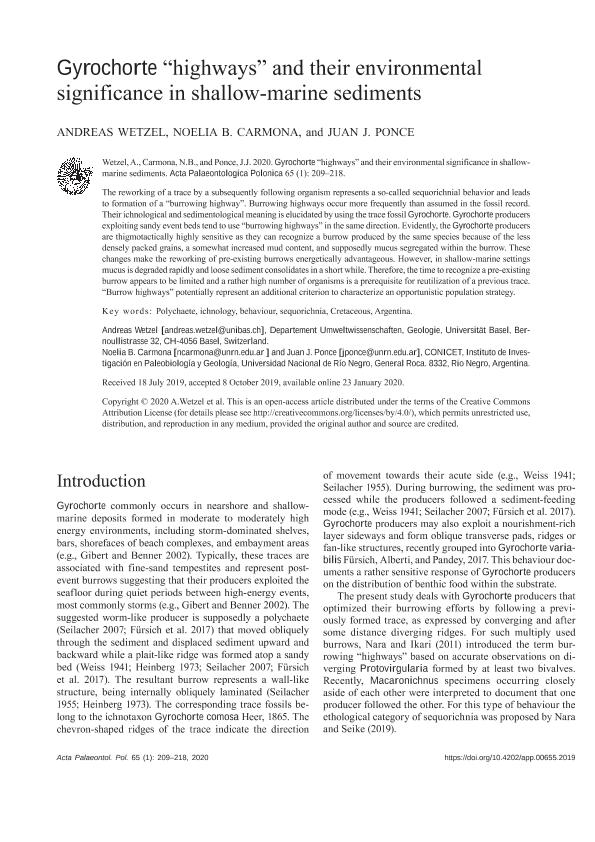Mostrar el registro sencillo del ítem
dc.contributor.author
Wetzel, Andreas
dc.contributor.author
Carmona, Noelia Beatriz

dc.contributor.author
Ponce, Juan Jose

dc.date.available
2021-11-17T18:45:25Z
dc.date.issued
2020-01
dc.identifier.citation
Wetzel, Andreas; Carmona, Noelia Beatriz; Ponce, Juan Jose; Gyrochorte "highways" and their environmental significance in shallow-marine sediments; Polish Academy of Sciences. Institute of Paleobiology; Acta Palaeontologica Polonica; 65; 1; 1-2020; 209-218
dc.identifier.issn
0567-7920
dc.identifier.uri
http://hdl.handle.net/11336/147080
dc.description.abstract
The reworking of a trace by a subsequently following organism represents a so-called sequorichnial behavior and leads to formation of a “burrowing highway”. Burrowing highways occur more frequently than assumed in the fossil record. Their ichnological and sedimentological meaning is elucidated by using the trace fossil Gyrochorte. Gyrochorte producers exploiting sandy event beds tend to use “burrowing highways” in the same direction. Evidently, the Gyrochorte producers are thigmotactically highly sensitive as they can recognize a burrow produced by the same species because of the less densely packed grains, a somewhat increased mud content, and supposedly mucus segregated within the burrow. These changes make the reworking of pre-existing burrows energetically advantageous. However, in shallow-marine settings mucus is degraded rapidly and loose sediment consolidates in a short while. Therefore, the time to recognize a pre-existing burrow appears to be limited and a rather high number of organisms is a prerequisite for reutilization of a previous trace. “Burrow highways” potentially represent an additional criterion to characterize an opportunistic population strategy
dc.format
application/pdf
dc.language.iso
eng
dc.publisher
Polish Academy of Sciences. Institute of Paleobiology

dc.rights
info:eu-repo/semantics/openAccess
dc.rights.uri
https://creativecommons.org/licenses/by-nc-sa/2.5/ar/
dc.subject
Polychaete
dc.subject
ichnology
dc.subject
behaviour
dc.subject
sequorichnia
dc.subject
Cretaceous
dc.subject
Argentina
dc.subject.classification
Geología

dc.subject.classification
Ciencias de la Tierra y relacionadas con el Medio Ambiente

dc.subject.classification
CIENCIAS NATURALES Y EXACTAS

dc.title
Gyrochorte "highways" and their environmental significance in shallow-marine sediments
dc.type
info:eu-repo/semantics/article
dc.type
info:ar-repo/semantics/artículo
dc.type
info:eu-repo/semantics/publishedVersion
dc.date.updated
2021-09-06T20:30:44Z
dc.identifier.eissn
1732-2421
dc.journal.volume
65
dc.journal.number
1
dc.journal.pagination
209-218
dc.journal.pais
Polonia

dc.description.fil
Fil: Wetzel, Andreas. Universität Basel; Suiza
dc.description.fil
Fil: Carmona, Noelia Beatriz. Consejo Nacional de Investigaciones Científicas y Técnicas; Argentina. Universidad Nacional de Río Negro. Sede Alto Valle. Instituto de Investigaciones en Paleobiología y Geología; Argentina
dc.description.fil
Fil: Ponce, Juan Jose. Consejo Nacional de Investigaciones Científicas y Técnicas; Argentina. Universidad Nacional de Río Negro. Sede Alto Valle. Instituto de Investigaciones en Paleobiología y Geología; Argentina
dc.journal.title
Acta Palaeontologica Polonica

dc.relation.alternativeid
info:eu-repo/semantics/altIdentifier/url/http://www.app.pan.pl/article/item/app006552019.html
dc.relation.alternativeid
info:eu-repo/semantics/altIdentifier/doi/https://doi.org/10.4202/app.00655.2019
Archivos asociados
